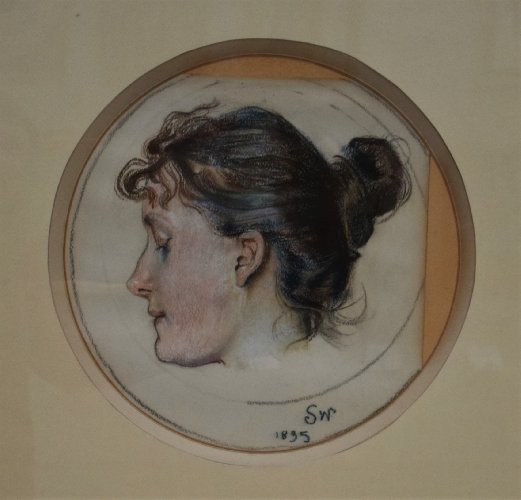Description:
Stanisław Wyspiański (1869-1907) had a great influence on the formation of his original and recognizable style. His studies in Krakow with Jan Matejko, travels and a few years stay in Paris with his friend, Józef Mehoffer had a particular impact on him. He was particularly impressed by the works of Van Gogh, Gauguin and Toulouse-Lautrec he encountered there. Allergic to oil paint, he began to mainly use pastels. Besides painting, he also engaged in graphics, decorative polychromy, stained glass design, theatrical staging, interior design and furniture, as well as writing poetry and dramas. His art, which falls into the program of the Young Poland, is characterized as symbolic, expressionist and Art Nouveau.
Description of the painting:
The portrait depicts the head of a young woman in profile. The profile line is marked with a strong, brown contour, clearly separating the face from the background. The model’s gaze is lowered, eyelids closed, eyelashes cast a shadow on the area under the eye. The face is delicately pink. Brown curls fall onto the forehead. The hair is tied up in a bun at the back of the head. The artist depicts the arrangement of the locks with great detail. The figure seems to be bathed in the rays of light, their reflections are particularly visible on the woman’s hair.
The model for Wyspiański was his aunt’s sister – Maria Waśkowska. The cousins knew each other since childhood, they were connected by an intimate relationship. The figure of the relative was a frequent image in the artist’s portraits. “At that time he painted three of my portraits. The first – a portrait in a light blue dress […] with a black velvet on the neck, dated February 1894, in the collection of MNW – A.Ł. The second – my portrait together with my younger sister, Fela, in red-checkered blouses. […] lost /?/ – A.Ł. The third is a pastel head in profile (1895); it is in the collection of H. Raczyński in Rogalin. He always painted my portraits in the late afternoon, when the setting sun threw light directly into the windows of my aunt’s apartment.”* It is estimated that the portrait may have been made in July 1895, when Maria was staying in Kazimierz and Joanna Stankiewicz in Krakow, where Wyspiański also arrived.


